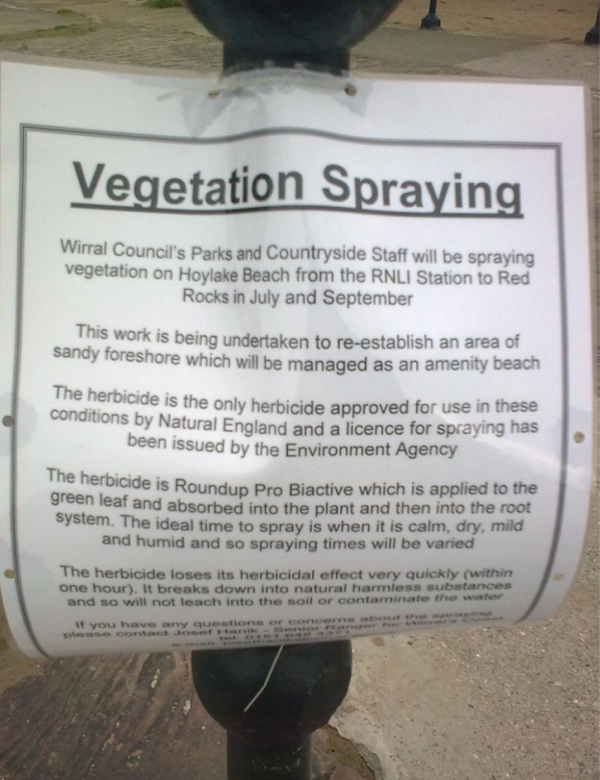As you can see from the notice above, the spartina grass that is spreading again on the beach is to be sprayed with a herbicide. Workers were out on the beach earlier, on what has been a rare dry day in recent weeks.
Presumably, treating the grass will be an ongoing process in the years ahead as each time it is “dealt with” it grows back again with renewed vigour.

Hmmm
much as Monsanto ‘crow’ on their website that “Roundup Pro Biactive is safe to everything except green plants” I’m not sure that should just be taken at face value.
The active ingredient, glyphosate, has been linked to health problems with studies suggesting several key areas of concern
http://www.ehow.com/list_7412792_risks-roundup.
Doe we really want this chemical repeatedly applied to our beach?
I would have preferred to see the beach deep plowed during spring and neap tides.
Yes, yes yes. It’s about time action was taken to get rid of the sparta grass. The dilution efect of sea water would remove any trace of chemicals. Without action Hoylake and Meols go the same way as Parkgate.
No beach just hoards of mosquitos.
GH
I have to say,I would much rather that chemicals were used to kill off the spartina, rather than leave it growing the way it is at present.
Lets just hope they get rid of it all, for the time being at least!
I know I keep saying this but this approach to ‘beach management’ is delusional and akin to that of King Knut.
Hoylake will not turn into Parkgate; the upper shore would revert to its natural sand dune ecology if only nature was left to itself instead of being subject to costly and futile grass removal which is a kind of King Knut approach in reverse. The vegetation on the beach is there because the tide too rarely covers the upper beach due to siltaton having raised beach levels, it is a symptom not the cause of a changed ecological situation. Killing the grass will not lower the beach levels.
Take a walk to the Red Rocks and enjoy the new sand dunes which are being formed between there and West Kirby; the same would have happened already between Beach Road and the Lifeboat Station were it not for current, misguided ‘beach management’ practices. A recent walk along the beach from Red Rocks to the Pinfold Lane steps was a delight with expanding ridges of sand dunes and ‘slacks’ developing atop a thin strip of saltings; there are masses of wild flowers and orchids. The council spent decades ploughing and spraying this area before giving it up as futile.
We need a campaign to stop this waste of public money and promote a naturalization of the Hoylake beach. I find it unbelievable that Natural England sanctions this kind of intervention on a designated Site of Special Scientific Interest.
Yes Peter, absolutely agree. I was up there during spraying and people were letting their dogs walk through pools of water covered with foam from the spays. Monsanto guarantees?? Worthless
There are some areas of the UK that take a disc harrow over the beach every evening and this picks up any litter but can also be used to pick up vegitional growths to keep the beaches clean..
However, the problem with the likes of Spartina grasses is that, if you plough the area, all you do is break them up so that next season they grow even stronger.